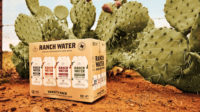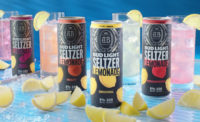Seltzer centric spirits look to unseat hard seltzers
With growth up 184%, spirits seltzers ‘shake things up’

With a taste of “paradise in a can,” Monaco Classic Mai Tai contains two shots of premium spirits and high-quality ingredients in sleek, sustainable cans.
(Image courtesy of Monaco Cocktails)
The idiom “there’s a new sheriff in town” denotes the arrival of a new authority figure coming into power to shake things up. Within the beer seltzer centric category, hard seltzers and lower ABV drinks remain hot. For the 52 weeks ending June 13, hard seltzers generated dollar sales of $4.3 billion in multi-outlet and convenience stores, a nearly 70% year-over-year (YoY) growth, Information Resources Inc. (IRI) data states. Yet, for that same time period, spirits seltzer centric brands grew 184% while amassing sales of $101 million. This triple-digit growth suggests that spirits seltzers is “shaking things up” as it looks to unseat the king of the alcohol beverage category growth.
There’s no doubt that consumers love their lower alcohol, lower sugar and calories fizzy drinks, but what’s the difference between hard seltzers and spirits seltzer-centric brands?
Simply put, hard seltzers typically are made from a base of fermented cane sugar with added flavors, but seltzers also can be made with malted barley, grain neutral spirits or wine. Spirit-based ready-to-drink (RTD) canned cocktails are most commonly formulated from a vodka or tequila base, says Kaleigh Theriault, client manager for beverage alcohol at New York-based NielsenIQ.
“Some RTDs are also utilizing whiskey, rum and gin, though those are much smaller in size,” Theriault says. “We even see some RTDs combining multiple alcohol bases in a single can. Specifically within spirits-based hard seltzers, both vodka and tequila bases are popping up as popular options.”
The seltzer and canned RTD market are exploding in size and innovation, as consumers seek convenient, on-the-go options that require no mixing or measuring on their part.

Image courtesy of Talkwalker
Albeit from a smaller base than the $3 billion, 6.9% YoY increase for flavored malt beverages (FMBs), spirits seltzer-centric brands saw YoY growth of 203% while notching dollar sales of $90 million in multi-outlets for the 52 weeks ending May 16, IRI data reports. Ranking No. 2 for YoY growth, premixed cocktails generated strong 68% growth and sales of $688 million. Other spirits including vodka, rum and gin saw much smaller YoY growth at 3.3%, 3.3% and 8.5%, respectively.
Within the spirits seltzer-centric category, High Noon is No. 1 in terms of dollar sales of nearly $71 million and 216% YoY growth in multi-outlets for the 52 weeks ending July 13, IRI reports. At No. 2 and No. 3 are Monaco and Canteen with sales of $9 million and $4 million, respectively, and YoY growth of 25.7% and 982%. Although not in the Top 5, Bacardi, with 4,084% growth and sales of $813,533, Devils Backbone, at 2,095% YoY growth and $211,310 in dollar sales, and Jack Daniels with 1,398% growth and sales of $183,651, are surging in popularity.
Launched in time for National Mai Tai Day (Aug. 30), Monaco Cocktails, a premium RTD, spirit-based canned cocktail from Atomic Brands, expanded its craft cocktail line with a new flavor: Classic Mai Tai. With a taste of “paradise in a can,” the 9% ABV drink contains two shots in every 12-ounce can and features a blend of light and dark rum with tropical notes and orange curacao, the company says. Other bartender-inspired varieties include a Kentucky Mule, made with bourbon and ginger beer, and a Moscow Mule, featuring vodka and ginger.
Significant channel shifting
The lingering impact of COVID-19, which hit full force in March 2020, prompted a swift shift from on-premise to off-premise as well as a significant shift from hard seltzers to premixed RTD cocktails.
“As this channel shift took place, we observed a rapid deceleration of hard seltzers, with share shifting from hard seltzers to pre-mix cocktail RTDs,” explains Taylor Katzman, CEO of Chicago-based Provi, a B2B eCommerce marketplace for the beverage alcohol industry currently active in 30 states.
He points out that under normal circumstances, he would have expected to see phenomenal hard seltzer performance as hard seltzers — which are beginning to transcend seasonal patterns — are highly seasonal with heavy volume growth being realized during the warmer months of the year.
| Individual Brands | Dollar Sales | % Change vs Prior Year | Market Share | % Change vs Prior Year |
| High Noon | $70,830,491 | 216.2 | 69.9 | 7.0 |
| Monaco | $9,263,653 | 25.7 | 9.1 | -11.5 |
| Canteen | $4,551,923 | 982.1 | 4.5 | 3.3 |
| Cutwater Spirits | $4,413,946 | 268.7 | 4.4 | 1.0 |
| Jose Cuvero | $3,594,228 | 321.3 | 3.6 | 1.2 |
| Category Total* | $101,275,556 | 184.2 | 100.0 | 0.0 |
* Includes brands not listed
Source: Information Resources Inc. (IRI), Chicago. U.S. supermarkets, drug stores, mass merchandisers, gas and convenience stores, military commissaries, and select club and dollar retail chains for the 52 weeks ending June 13.
“However, during the summer of 2020, hard seltzers had decelerated from being up more than 1,000% YoY on a three month basis through February, to being up just 1.1% by June, with notable on-premise declines attributed to White Claw and Truly,” Katzman says. “As these declines took place, we observed the rapid acceleration of pre-mix cocktail RTDs, with heavy growth driven by the brands such as Jack Daniels Country Cocktails and High Noon Sun Sips.
“However, as the on-premise has begun to reopen over the past couple of months, we are seeing share shifting heavily in favor of hard seltzers, with the usual suspects (White Claw and Truly) driving rapid increases in growth,” he continues. “On a three month basis through the end of June, case volumes are up 600% vs. last year, and continue to trend upwards.”
NielsenIQ’s Theriault also has noticed the shift and the blurring of the lines between categories. Over the past year, the company has expanded its lens from only hard seltzers to eyeballing RTDs across beer, wine and spirits, she says.
“For the latest 52 weeks ending June 5, 2021, total RTDs across beer, wine, and spirits was $3.7 billion, with malt-based hard seltzers accounting for almost half of the sales,” Theriault notes. “Spirits-based RTDs are still relatively small in comparison, representing 5.4% of total RTDs. Malt-based hard seltzer drinkers are 214% more likely to purchase ready-to-drink spirits cocktails.”
Noting that it’s possible for any market to become oversaturated, Theriault suggests that differentiation is key.
“Differentiation in flavor profiles or various additives — lemonade, tea, fruit juices, etc. — will help to set a brand apart from other competitors,” she explains. “Hard seltzers and RTD launches that are made with health-minded ingredients are also likely to set themselves apart from other brands. … Drinkers are very interested in unique flavor profiles, but not too bold of taste.”
Looking for a reprint of this article?
From high-res PDFs to custom plaques, order your copy today!






